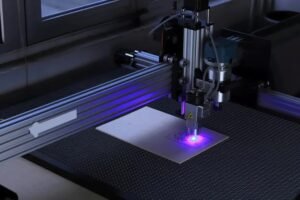Advanced CO2 Laser Technology

In the ever-evolving landscape of technological innovation, few advancements have had as profound an impact across multiple industries as the development and refinement of CO2 laser technology. Since its inception in the 1960s, CO2 lasers have been a cornerstone in applications ranging from medical treatments and surgical procedures to industrial manufacturing and materials processing. The versatility and precision of CO2 lasers stem from their unique ability to emit infrared light at a wavelength particularly suited for interacting with organic and inorganic materials, making them indispensable tools in both scientific research and commercial applications.
This article delves into the intricate world of advanced CO2 laser technology, exploring its fundamental principles, recent breakthroughs, and diverse applications. We will examine how continuous improvements in laser design, beam quality, and power output have expanded the capabilities of CO2 lasers, enabling more efficient and precise operations. Additionally, we will highlight the significant role of CO2 lasers in driving innovation in fields such as medicine, where they facilitate minimally invasive surgeries and advanced diagnostic techniques, and in industry, where they enhance manufacturing processes through precise cutting, engraving, and welding.
By understanding the evolution and current state of CO2 laser technology, we can better appreciate its impact on modern science and industry, and anticipate future advancements that promise to push the boundaries of what is possible. Whether you are a professional in the field, a researcher, or simply an enthusiast of cutting-edge technology, this comprehensive exploration of advanced CO2 laser technology will provide valuable insights into one of the most dynamic and influential tools of our time.
What is CO2 Laser Technology?
A CO2 laser is a type of gas laser where the primary lasing medium is carbon dioxide. It operates at a wavelength of around 10.6 micrometers in the infrared spectrum. The high power and efficiency of CO2 lasers make them ideal for cutting, engraving, and marking a wide variety of materials, including metals, plastics, wood, and textiles. In the medical field, they are used for soft tissue surgeries due to their precision and ability to minimize damage to surrounding tissues.
Recent Advancements in CO2 Laser Technology
- Improved Beam Quality and Precision: Recent developments have focused on enhancing the beam quality of CO2 lasers. Advances in optical components and resonator designs have resulted in lasers with better focusability and smaller spot sizes. This improvement allows for finer cuts and more detailed engraving, essential for applications requiring high precision, such as microelectronics and intricate medical procedures.
- Enhanced Power Efficiency: Modern CO2 lasers are more power-efficient, thanks to innovations in gas flow dynamics and cooling systems. Enhanced designs reduce the amount of energy required to achieve the same output, making these lasers more environmentally friendly and cost-effective. This is particularly beneficial in large-scale industrial applications where energy consumption is a significant concern.
- Integration with Digital and Automated Systems: The integration of CO2 lasers with digital control systems and automation has revolutionized their application. Advanced software now allows for precise control of the laser parameters, enabling complex cutting and engraving patterns to be executed with minimal human intervention. This has opened up new possibilities in manufacturing, where high precision and repeatability are crucial.
- Versatility in Material Processing: The capability of CO2 lasers to process a diverse range of materials has been further enhanced. Innovations in laser modulation and the development of hybrid systems combining CO2 lasers with other types of lasers, such as fiber lasers, have expanded the range of materials that can be effectively processed. This versatility is particularly advantageous in industries like aerospace and automotive, where a variety of materials are used.
- Advanced Safety Features: With the increased use of CO2 lasers in various fields, ensuring operator safety has become a priority. Modern CO2 laser systems come equipped with advanced safety features, including real-time monitoring, automatic shutdown in case of system failure, and improved shielding. These features protect users from potential hazards, making the technology safer to use in both industrial and medical environments.
Applications of Advanced CO2 Laser Technology
- Medical and Surgical Applications: CO2 lasers are extensively used in medical procedures, particularly in dermatology, ophthalmology, and surgery. The precise control of the laser allows for minimally invasive surgeries with reduced recovery times. Recent advancements have improved the safety and efficacy of these procedures, enabling more widespread adoption.
- Industrial Manufacturing: In manufacturing, CO2 lasers are employed for cutting, welding, and engraving a variety of materials. The advancements in beam quality and control systems have made these processes more efficient and precise, leading to higher-quality products and reduced waste.
- Aerospace and Automotive Industries: The aerospace and automotive industries benefit significantly from CO2 laser technology due to its ability to process lightweight and composite materials. The improved precision and efficiency of modern CO2 lasers contribute to the production of components that meet stringent industry standards.
- Art and Design: Artists and designers utilize CO2 lasers for creating intricate patterns and designs on various materials. The ability to achieve fine details and the flexibility offered by advanced CO2 laser systems have expanded the creative possibilities in these fields.
Future Directions
The future of CO2 laser technology looks promising, with ongoing research focusing on further improving efficiency, expanding material compatibility, and integrating with emerging technologies such as artificial intelligence and machine learning.
These advancements will likely lead to even more innovative applications and increased adoption across different sectors.
Transitions and frequencies
Since the laser transitions are actually on the vibrational rotation bands of a linear triatomic molecule, the rotational structure of the P and R bands can be determined by a tuning element in its cavity.
Prisms are not practical as tuning elements because most media transmitting in the mid-IR absorb or scatter some light, so the frequency tuning element is almost always a diffraction grating.
By rotating the diffraction grating, a specific line of rotation for the vibrational transmission can be selected. The best frequency selection can also be obtained through the use of an etalon. In practice, combined with isotope substitution, this means that a continuous range of frequencies separated by about 1 cm (30 GHz) extending from 880 to 1090 cm can be used.
“Linearly tunable” CO2 lasers are of fundamental interest in research applications.
The resulting wavelength is affected by the specific isotopes present in the carbon dioxide molecule, with heavier isotopes emitting longer wavelengths. Due to the high power levels available combined with the reasonable cost of the laser, it is frequently used in industrial applications for cutting and welding, while at Low energy engraving. It is also used in the additive manufacturing process of selective laser sintering.
Materials and objects
A laser suitable for engraving and cutting many materials and objects perfectly, such as:
Carbon dioxide laser engraving in paper and cardboard
Laser machines allow the creation of many objects and details that are impossible to recreate using regular cutters or plotters. Moreover, colored paper can also be engraved using the same machine to obtain great results with just a few minutes of work, without adding any inks or other special additives.
Using laser machines, it is also possible to cut white paper without a “burnt” effect along the cutting edge, even on very complex shapes.
Laser engraving in plastics and methacrylate
The laser is suitable for engraving and cutting on plexiglass or PMMA to perfection, all with the highest possible precision even on very complex shapes, and the cutting edge is always shiny and does not require further finishing.
Various plastic materials can be embossed and shaped such as: polyamide (PA), polycarbonate (PC), PCB, mylar, polyethylene, laminated plastic, polyethylene (PE), polypropylene (PP), polyoxymethylene ( POM), polysulfone (PSU, PPSU), polyether ketone (PEEK), acrylonitrile butadiene styrene (ABS), polyimide (PI), polystyrene (PS), polymethyl methacrylate (PMMA), polyester (PES), polyethylene Terephthalate (PET), etc.
Carbon dioxide laser engraving in wood
Wood engraving is one of the most widely used applications because it relates to a large number of products, especially those that involve customization. In fact, infinite operations can be performed on a wide range of soft, hard or varnished woods, and therefore on numerous products: industrial tools, toys, gifts, souvenirs and furniture accessories.
Creativity is the only limit when it comes to wood and plywood.
Fabrics and leather
Among the different materials and objects that can be processed with a laser, we certainly find: genuine leather, suede, suede, nubuck, faux leather, Alcantara, bracelets, belts, shoes, handbags, wallets, document holders, clothing, accessories, materials Promotional, Office Arttilo da.
Allows you to cut and engrave a large number of fabrics very quickly and easily. Thanks to laser engraving, it is possible to give materials a high-quality tactile effect and offers endless processing possibilities, including felt engraving and cutting original shapes on polyester and silk.
The types of fabrics suitable for laser processing are for example: cotton, felt, silk, linen, lace, polyester, wool, softshell, denim, nylon, satin, kevlar, vinyl, denim, microfiber, alcantara, neoprene, etc.
Drilling in glass
Glass engraving has never been so easy and instant, with extraordinary results, a rotary accessory isn’t always necessary to customize your items!
Cups, bottles, jugs, plates, ceramics, mugs, wine glasses, windows, furniture components, etc.
Drilling in stone and marble
Surprising results on materials such as trays, tiles, marble, trophies, rocks…
Through laser engraving, you can obtain photographic results with very high detail on these materials, making them unique pieces. There are also special paints for stone and marble on the market, which also make your engravings permanently colorful.
Drilling in plated metals and anodized aluminum
The C02 laser allows you to easily work on these materials, effectively removing aluminum oxide coatings on various objects, such as: identification plates, pet tags, tools, electronic and computer components, bottle openers, and indoor and outdoor signs.
Conclusion
Advanced CO2 laser technology represents a significant leap forward in various fields, from industrial manufacturing to medical applications. Its precision, versatility, and efficiency make it an invaluable tool for cutting, welding, engraving, and treating a wide range of materials with exceptional accuracy and minimal thermal damage.
In the medical field, CO2 lasers have revolutionized surgical procedures, enabling minimally invasive techniques that reduce recovery times and improve patient outcomes. Dermatology, ophthalmology, and dental practices have particularly benefited from the precise control and reduced collateral damage that CO2 lasers offer.
Industrially, the advancements in CO2 laser technology have streamlined production processes, enhancing the quality and speed of manufacturing. The ability to cut complex shapes with high precision has opened new possibilities in the automotive, aerospace, and electronics industries, contributing to innovations and cost efficiencies.
Research and development continue to push the boundaries of what CO2 lasers can achieve. Innovations such as adaptive optics, real-time monitoring, and integration with artificial intelligence are set to further enhance the capabilities and applications of CO2 lasers. As these technologies evolve, we can expect even greater precision, efficiency, and adaptability, making CO2 lasers an integral part of future technological advancements.
Overall, the advanced CO2 laser technology not only demonstrates the power of precision and control in various applications but also exemplifies the ongoing progress in laser technology. This progress promises continued improvements in both industrial and medical fields, ultimately contributing to better products, procedures, and outcomes across a broad spectrum of uses.




